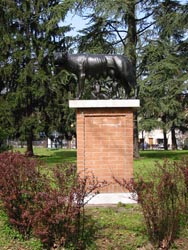Reggio Emilia Local Monuments |
| 1) WWI Memorial |
This work is called Lupa Capitolina, and it is a monument of Roman tradition which wants to magnify the fascist period.
It was created during the fascist government in more than one copy, and was sent to Reggio Emilia in the half of the 1930s, probably in 1935.
It is one of the many modern copies, derived from the renowned Etrurian bronze kept at “Palazzo dei Conservatori” museum in Rome, and sent to many Italian cities during the fascist period. Lupa Capitolina exemplifies the high quality and originality of Etrurian sculpture at the beginning of the V century AD. It represents the animal (a wolf) in a nervous and rigid pose. The tension of this pose is visible in the intensity of the head.
There is no information as to whom did it; surely it was made by a group of artisans who in the fascist period produced many copies of the work which were sent to many Italian cities.
The work represents the thanksgiving homage by the leader Mussolini to the city for the participation in the Roman exhibition in Rome in 1937.
The monument is placed in the Public Gardens in Reggio Emilia which represent a significant environmental unit, and it communicates with the nearby historic centre. The Public Gardens with their theatres and museums are the place meant for culture and recreation. The Gardens were built in 1850, in the area where the Citadella was, and the engineer Giuseppe Balzaretti built them. The Gonzaga family built the cittadella in 1339, (this family was the most important of Reggio Emilia). The Citadella was a system of defence and it had very strong walls and wide ditches. Between 1848 and 1867 this fort was demolished. Later, a lot of monuments and statues were placed to embellish the public Gardens, the Lupa Capitolina was an example. The Public Gardens started as a place of cultural aggregation and of immersion in the vegetation . So the Lupa Capitolina, symbol of our Roman origins, was placed in the Public Gardens because of their central role in the city.
Mussolini donated the Lupa Capitolina to Reggio Emilia, because our city had taken part in the exhibition of Roman Culture held in Rome in 1937. Reggio Emilia in fact sent various monuments, found in its territory.
The Lupa capitolina had another aim: to represent the roman origins of the town and its connection with Fascist Rome. The monument wants to evoke the glorious fascist empire, comparing it to the power of the Roman Empire.
The monument remained in the Public Gardens until 1980 about, later it was moved for restoration. Now the monument is again in its original place: the Public Gardens.
Information found in the following book: E. Farioli, L. Rivi (edited by),I luoghi ritrovati. Guida ai Giardini Pubblici, Reggio Emilia City Council and Civic museums, 2002. Le statue Restaurate, edited by Luciano Rivi, Reggio Emilia, 2002.
